《病理学》课程教学课件(PPT讲稿)第十三章 内分泌系统疾病 Diseases of the endocrine system
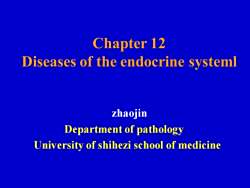
Chapter12Diseases of the endocrine systemlzhaojinDepartment ofpathologyUniversity of shihezi school of medicine
Chapter 12 Diseases of the endocrine systeml zhaojin Department of pathology University of shihezi school of medicine
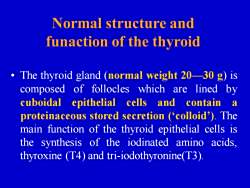
Normal structure andfunaction of the thyroid The thyroid gland (normal weight 20-30 g) isof follocleswhichlinedcomposedarebycellscuboidalepithelialandcontainaproteinaceous stored secretion (colloid'). Themain function of the thyroid epithelial cells isacids,the synthesis of the iodinated aminothyroxine (T4) and tri-iodothyronine(T3)
Normal structure and funaction of the thyroid • The thyroid gland (normal weight 20—30 g) is composed of follocles which are lined by cuboidal epithelial cells and contain a proteinaceous stored secretion (‘colloid’). The main function of the thyroid epithelial cells is the synthesis of the iodinated amino acids, thyroxine (T4) and tri-iodothyronine(T3)
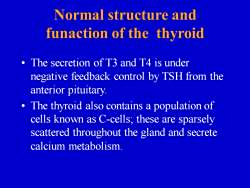
Normal structure andfunaction of the thyroid. The secretion of T3 and T4 is undernegative feedback control by TSH from theanterior pituitary The thyroid also contains a population ofcells known as C-cells; these are sparselyscattered throughout the gland and secretecalcium metabolism
Normal structure and funaction of the thyroid • The secretion of T3 and T4 is under negative feedback control by TSH from the anterior pituitary. • The thyroid also contains a population of cells known as C-cells; these are sparsely scattered throughout the gland and secrete calcium metabolism
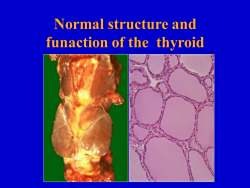
Normal structure andfunaction of the thyroid
Normal structure and funaction of the thyroid
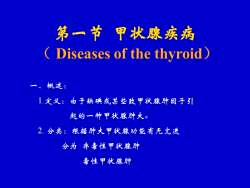
第一节甲状腺疾病(Diseases of the thyroid)概述:1.定义:由于缺碘或某些致甲状腺肿因子引起的一种甲状腺肿大。2.分类:根据肿大甲状腺功能有无亢进分为 非毒性甲状腺肿毒性甲状腺肿
第一节 甲状腺疾病 ( Diseases of the thyroid) 一、概述: 1.定义:由于缺碘或某些致甲状腺肿因子引 起的一种甲状腺肿大。 2. 分类:根据肿大甲状腺功能有无亢进 分为 非毒性甲状腺肿 毒性甲状腺肿
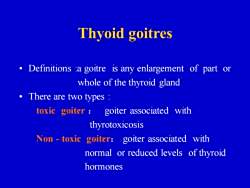
Thyoid goitres: Definitions :a goitre is any enlargementofpart orwhole of the thyroid glandThere are two types :toxicgoiter associated withgoiter :thyrotoxicosiswithNon - toxicgoiter:goiter associatednormal or reduced levels of thyroidhormones
Thyoid goitres • Definitions :a goitre is any enlargement of part or whole of the thyroid gland • There are two types : toxic goiter : goiter associated with thyrotoxicosis Non - toxic goiter: goiter associated with normal or reduced levels of thyroid hormones
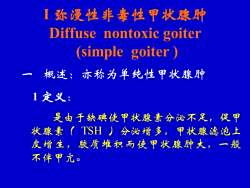
I弥漫性非毒性甲状腺肿Diffuse nontoxic goiter(simple goiter)概述:亦称为单纯性甲状腺肿1 定义:是由于缺碘使甲状腺素分泌不足,促甲状腺素(TSH )分泌增多,甲状腺滤泡上皮增生,胶质堆积而使甲状腺肿大,:一般不伴甲亢
I 弥漫性非毒性甲状腺肿 Diffuse nontoxic goiter (simple goiter ) 一 概述:亦称为单纯性甲状腺肿 1 定义: 是由于缺碘使甲状腺素分泌不足,促甲 状腺素( TSH )分泌增多,甲状腺滤泡上 皮增生,胶质堆积而使甲状腺肿大,一般 不伴甲亢
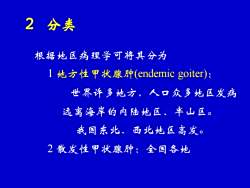
2分类根据地区病理学可将其分为1 地方性甲状腺肿(endemic goiter):世界许多地方、人口众多地区发病远离海岸的内陆地区、半山区。我国东北、西北地区高发。2散发性甲状腺肿:全国各地
2 分类 根据地区病理学可将其分为 1 地方性甲状腺肿(endemic goiter): 世界许多地方、人口众多地区发病 远离海岸的内陆地区、半山区。 我国东北、西北地区高发。 2 散发性甲状腺肿:全国各地
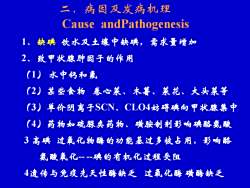
二、病因及发病机理Cause andPathogenesis1、缺碘饮水及土壤中缺碘,需求量增加2、 致甲状腺肿因子的作用(1)水中钙和氟(2)某些食物卷心菜、木薯、菜花、大头菜等(3)单价阴离子SCN、CLO4妨碍碘向甲状腺集中(4)药物如硫脲类药物、磺胺制剂影响碘酪氨酸3 高碘 过氧化物酶的功能基过多被占用, 影响酪氮酸氧化----碘的有机化过程受阻4遗传与免疫先天性酶缺乏过氧化酶磺酶缺乏
二.病因及发病机理 Cause andPathogenesis 1、缺碘 饮水及土壤中缺碘,需求量增加 2、致甲状腺肿因子的作用 (1) 水中钙和氟 (2)某些食物 卷心菜、木薯、菜花、大头菜等 (3)单价阴离子SCN、CLO4妨碍碘向甲状腺集中 (4)药物如硫脲类药物、磺胺制剂影响碘酪氨酸 3 高碘 过氧化物酶的功能基过多被占用,影响酪 氨酸氧化- -碘的有机化过程受阻 4遗传与免疫先天性酶缺乏 过氧化酶 磺酶缺乏
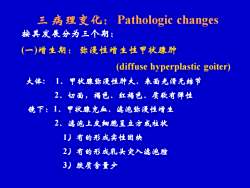
三病理变化:Pathologicchanges按其发展分为三个期:(一)增生期:弥漫性增生性甲状腺肿(diffuse hyperplastic goiter)大体:1、甲状腺弥漫性肿大、表面光滑无结节2、切面,褐色、红褐色、质软有弹性镜下:1、甲状腺充血、滤泡弥漫性增生2、滤泡上皮细胞呈立方或柱状1)有的形成实性团块2)有的形成乳头突入滤泡腔3)胶质含量少
三 病理变化: Pathologic changes 按其发展分为三个期: (一)增生期: 弥漫性增生性甲状腺肿 (diffuse hyperplastic goiter) 大体: 1、甲状腺弥漫性肿大、表面光滑无结节 2、切面,褐色、红褐色、质软有弹性 镜下:1、甲状腺充血、滤泡弥漫性增生 2、滤泡上皮细胞呈立方或柱状 1)有的形成实性团块 2)有的形成乳头突入滤泡腔 3)胶质含量少
按次数下载不扣除下载券;
注册用户24小时内重复下载只扣除一次;
顺序:VIP每日次数-->可用次数-->下载券;
- 《病理学》课程教学课件(PPT讲稿)第十三章 内分泌系统疾病.ppt
- 《病理学》课程教学资源(实验指导)实验三 局部血液循环障碍.doc
- 《病理学》课程教学资源(实验指导)实习一 细胞、组织的损伤、修复与适应(一).doc
- 《病理学》课程教学资源(实验指导)实习二 细胞、组织的损伤、修复与适应(二).doc
- 《病理学》课程教学资源(实验指导)实习四 炎症.doc
- 《病理学》课程教学资源(实验指导)实习六 肿瘤(二).doc
- 《病理学》课程教学资源(实验指导)实习五 肿瘤(一).doc
- 《病理学》课程教学资源(实验指导)实习七 肿瘤(三).doc
- 《病理学》课程教学资源(实验指导)实习八 心血管系统疾病(一).doc
- 《病理学》课程教学资源(实验指导)实习十 呼吸系统疾病(一).doc
- 《病理学》课程教学资源(实验指导)实习九 心血管系统疾病(二).doc
- 《病理学》课程教学资源(实验指导)实习十一 呼吸系统疾病(二).doc
- 《病理学》课程教学资源(实验指导)实习十五 传染病.doc
- 《病理学》课程教学资源(实验指导)实习十四 泌尿、内分泌、神经系统疾病.doc
- 《病理学》课程教学资源(实验指导)实习十二 消化系统疾病(一).doc
- 《病理学》课程教学资源(实验指导)实习十三 消化系统疾病(二).doc
- 《病理学》课程教学资源(授课教案)第二章 损伤的修复.doc
- 《病理学》课程教学资源(授课教案)第一章 绪论.doc
- 《病理学》课程教学资源(授课教案)第五章 肿瘤.doc
- 《病理学》课程教学资源(授课教案)第四章 炎症.doc
- 《病理学》课程教学课件(PPT讲稿)第十一章 泌尿系统疾病(二).ppt
- 《病理学》课程教学课件(PPT讲稿)第八章 消化系统疾病.ppt
- 《病理学》课程教学课件(PPT讲稿)第七章 呼吸系统疾病.ppt
- 《病理学》课程教学课件(PPT讲稿)第十五章 传染病(Infectious Disease).ppt
- 《病理学》课程教学课件(PPT讲稿)第十一章 泌尿系统疾病(一).ppt
- 《病理学》课程教学课件(PPT讲稿)第三章 局部血液循环障碍.ppt
- 《病理学》课程教学课件(PPT讲稿)第六章 心血管系统疾病.ppt
- 《病理学》课程教学课件(PPT讲稿)第五章 肿瘤.ppt
- 《病理学》课程教学课件(PPT讲稿)第四章 炎症(石河子大学:潘晓琳).ppt
- 《病理学》课程教学课件(PPT讲稿)第一章 细胞和组织的适应与损伤.ppt
- 《病理学》课程教学课件(PPT讲稿)第二章 损伤的修复.ppt
- 华北理工大学(河北联合大学):《组织学与胚胎学》课程教学资源(理论教案)第十二章 消化腺.doc
- 华北理工大学(河北联合大学):《组织学与胚胎学》课程教学资源(理论教案)第二章 上皮组织.doc
- 华北理工大学(河北联合大学):《组织学与胚胎学》课程教学资源(理论教案)第三章 结缔组织.doc
- 华北理工大学(河北联合大学):《组织学与胚胎学》课程教学资源(理论教案)第一章 绪论.doc
- 华北理工大学(河北联合大学):《组织学与胚胎学》课程教学资源(理论教案)第十三章 呼吸系统.doc
- 华北理工大学(河北联合大学):《组织学与胚胎学》课程教学资源(理论教案)第四章 软骨和骨.doc
- 华北理工大学(河北联合大学):《组织学与胚胎学》课程教学资源(理论教案)第五章 血液.doc
- 华北理工大学(河北联合大学):《组织学与胚胎学》课程教学资源(理论教案)第十四章 泌尿系统.doc
- 华北理工大学(河北联合大学):《组织学与胚胎学》课程教学资源(理论教案)第六章 肌组织.doc
